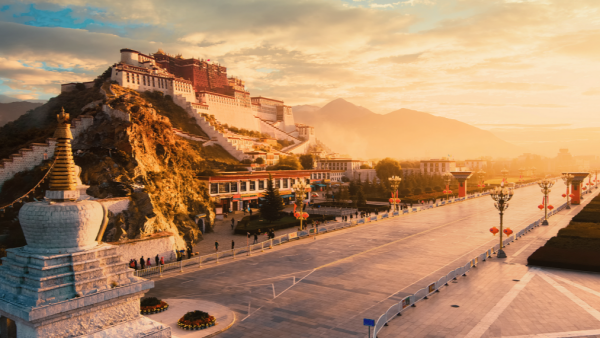


Xizang writes a new chapter in economic development

The Potala Palace, Lhasa, China's Xizang Autonomous Region. /CFP
Xizang in southwest China is renowned for its magnificent natural scenery and unique cultural charm. However, for a long time, its remote geographical location, inconvenient transportation, and harsh natural conditions were shackles, severely restricting the realization of the region's growth potential.
Once characterized by a weak economic foundation, a late start in development, a small market scale, and a small economic aggregate, Xizang today is writing a new chapter in economic development under the forward-looking policies and support of the Chinese government.
Consolidation of achievements and income growth
In the past, Xizang had the highest poverty incidence, the deepest poverty level, the greatest difficulty in poverty alleviation and the highest poverty alleviation cost in China. Since the 18th National Congress of the Communist Party of China (CPC) in 2012, which focused on the development of different regions within the broader context of national development and stability, Xizang has followed the strategy of targeted poverty alleviation and elimination. It has promoted industrial development, relocation from harsh terrains, ecological compensation, education development, and social security.
By the end of 2019, a total of 628,000 registered poor people had been lifted out of poverty. In 2024, the per capita net income of Xizang's poverty-relieved population increased by more than 12.5 percent. This data shows the remarkable results in improving the living standards of the poverty-relieved population.
Take Yumai, a township in the city of Shannan City, as an example. It has integrated border defense and rural revitalization, implemented relocation, and improved infrastructure such as housing, roads, water and electricity, and communications. It has also developed various industries such as tourism and handicraft processing in accordance with local conditions. Today, its per capita annual income is over 40,000 yuan ($5568). The township has become a model for the development of Xizang's border areas.
In Xigaze, a city in south-central Xizang, a campaign to raise the income of farmers and herdsmen was carried out in 2024 by expanding job avenues. The per capita net income of the sampled poverty-relieved population reached 22,559.65 yuan ($ 3140), an increase of 27.33percent year on year; the per capita disposable income of rural residents in the city was 19,668 yuan ($2737), an increase of 8.8 percent.
These data show the measures taken to increase the income of poverty-relieved people and rural residents in Xizang have effectively improved their living standards.
Strong overall economic growth momentum
From the perspective of macroeconomic data, Xizang has made remarkable development in recent years. In 2024, its GDP grew by 6.3 percent, and the per capita disposable income of urban and rural residents increased by 6.8 percent and 8.3 percent respectively. The growth rate of major economic indicators ranked among the highest in the country. The number of permanent residents was 3.65 million in 2023. The expanded overall economic scale and the coordinated development of the population and economy laid a solid foundation for the improvement of people's living standards.
Agriculture and animal husbandry, Xizang's basic industry, plays an important role in economic development. In 2024, the sector achieved remarkable results. The total grain output of 1.129 million tons, an increase of 3.8 percent, exceeded 1 million tons for the first time. The sound development of agriculture and animal husbandry has ensured food security and raised the incomes of farmers and herdsmen, fundamentally improving their quality of life.
Booming cultural and tourism industry
Xizang's rich historical and cultural resources and unique natural scenery provide unique conditions for the development of the cultural and tourism industry. In recent years, the cultural and tourism industry has become a strategic pillar industry. In 2024, the output value of Xizang's cultural industry crossed 11 billion yuan, an increase of 23.8 percent year on year. The region received more than 63 million domestic and foreign tourists, an increase of 15.81 percent year on year, with a total tourism expenditure of 74.5 billion yuan, an increase of 14.5 percent year on year.
The vigorous development of the cultural and tourism industry has created jobs, showcased local culture, and brought more development opportunities and income sources.
Increasing market vitality
Market entities are the micro-foundation of economic development, reflecting the activity of the regional economy. By the end of 2024, there were 557,000 market entities in Xizang, an increase of 11.43 percent over the previous year; the number of new market entities throughout the year was 97,300, an increase of 8.14 percent. The increase indicates that Xizang's business environment is optimized and the endogenous driving force for economic development is enhanced. The emergence of various enterprises and merchants has created more jobs, promoted the circulation of goods and services, and provided more possibilities for the improvement of people's living standards.
These achievements cannot be separated from the leadership of the government and the joint efforts of all ethnic groups in Xizang. As a new Xizang full of vitality and hope emerges, the advancement of various policies and support will ensure the continuation of the momentum of economic development.
Liu Chunsheng is an associate professor at the Beijing-based Central University of Finance and Economics.
Editor:Yu Hui
Copyright©2023 CSSN All Rights Reserved